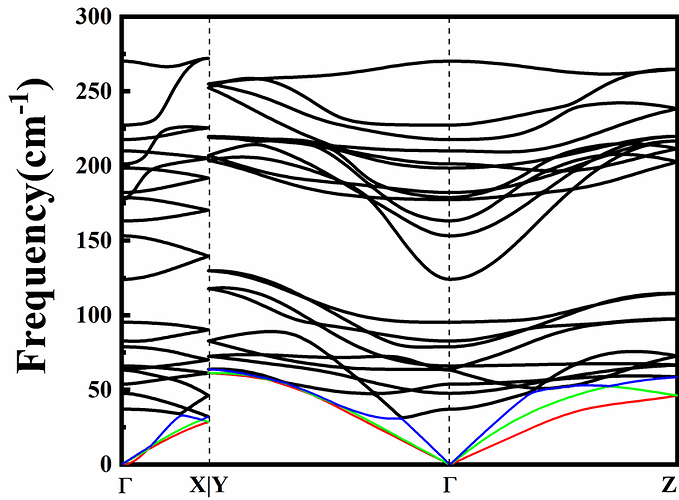I am also tangling with the “pop_frequency” tag in the setting.yaml these days. In AMSET example, it happens that both GaAs and Si system only have one LO-TO splitting phonon band, so it seems that LO happens to be the phonon band with the highest phonon frequency. But in SnS system I calculate, there seems to be more than one optic phonon band that are splitting. So should I still use “the frequency of the highest phonon band” as the input in “pop_frequency” tag?
Also I have read the part about using command
amset phonon-frequency
to extract the weighted-sum polar optic phonon frequency. Is this method helps in solving the problems I met in SnS? Anyway ,I ran the command but only get a effective frequency equals 0 THz. I don’t know if this means my DFPT calculation goes wrong?
FYI, I have attached the phonon dispersion of SnS I calculated here and the output after I entered the command amset phonon-frequency in SnS DFPT calculation directory:
Frequency Weight
--------- ------
-0.01 0.00
-0.01 0.00
-0.00 0.00
-0.00 0.00
-0.00 0.00
-0.00 0.00
0.00 0.06
0.00 0.94
0.00 0.00
0.00 0.00
1.11 0.00
1.92 0.00
2.00 0.00
2.34 0.00
2.76 0.00
2.86 0.00
5.12 0.00
5.43 0.00
5.56 0.00
6.20 0.00
6.47 0.00
6.61 0.00
6.63 0.00
8.25 0.00
effective frequency: 0.00 THz
Response: Something appears to have gone terribly wrong with your DFPT calculation. You can see there are 10 Gamma-point phonon modes with a frequency of zero when there should only be 3 (the acoustic modes). You should check your calculation settings to ensure that
- You are running DFPT on a very tight relaxed structure. Example calculation settings are described here. The forces on the atoms and lattice should be close to zero.
- That you are using tight energy convergence for the DFPT calculation itself. Example VASP input settings are here.
- Check your DFPT calculation reached energy convergence for each perturbation.
If you try these things and this does not fix your problem, please upload your INCAR and OUTCAR files and I will try and troubleshoot further.
